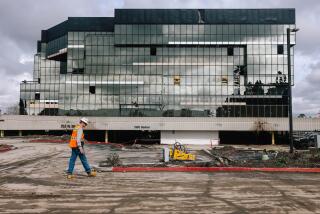SAN JUAN CAPISTRANO : Test Firm’s Offices Rise Amid Wilds
- Share via
Drivers cruising along scenic Ortega Highway are beginning to see a new structure poking out of the wilderness.
About nine miles east of Interstate 5, the steel-and-mirrored-glass headquarters of the Nichols Institute, a medical research and testing laboratory based in San Juan Capistrano, is taking shape amid the oaks and alders on a hillside next to Lucas Canyon and Ronald W. Caspers Wilderness Park.
Its appearance in the pristine landscape is either the final chapter of an old horror story or the fulfillment of a lifetime dream, depending on whom you ask.
For environmentalists, the Nichols headquarters is a reminder of a battle lost.
“We’re still upset about it because we believe it has destroyed the area totally,” said Ilysa Byrnes of San Juan Capistrano, who was part of an environmental coalition that fought the project for nearly a decade. “The Sierra Club was against it, and the Audubon Society. We even had former Atty. Gen. John Van de Kamp on our side. But the (County) Board of Supervisors ignored everything.”
For Dr. Albert Nichols of Laguna Beach, however, the 230,000-square-foot headquarters is the realization of a dream that began when he started his company in 1972 in San Pedro. By 1980, when he purchased the 100 acres off Ortega Highway from the O’Neill family, he was looking for an area that “fosters creativity,” said Katherine F. Murphy, the institute’s spokesperson.
“Our mission is to improve health and patient care,” Murphy said. “In order to do that, we need almost a campus atmosphere conducive to research, education and staff development.”
Campus is the term Murphy uses for the future headquarters, which will consist of two main buildings of two stories each, where each floor is “approximately one acre in size,” Murphy said. While 95% of the company’s revenues are derived from performing medical tests for physicians around the nation, the headquarters will be more than a testing facility and will include laboratories for research and development, a conference center, cafeteria, outdoor seating areas, amphitheater and a heliport.
“We are attempting to retain the natural character of the land by preserving vistas and native vegetation,” Murphy said, adding that the company is in the process of bringing in and planting 800 more trees, “all indigenous to California.”
Only 20 acres of the site will be developed, Murphy said, with the remaining property left in its natural state. The company pipes in its own well water and has designed a water-reclamation system to conserve and reuse whatever water is needed, Murphy said.
But those measures do little to soothe the feelings of environmentalists. Just the fact that the headquarters is made of mirrored glass is a sore point, said Ken Fortune, president of the South Coast Audubon Society.
“Birds aren’t savvy enough to realize it’s glass and, boom, they smack into the walls. It happens all the time,” Fortune said. “No, I can’t say we’re real impressed with what they’ve done.”
Fortune lists the helicopter flights in and out of the facility, traffic problems on two-lane Ortega Highway and trucks laden with chemicals and hazardous materials as just a few of the Audubon Society’s concerns. The Audubon Society was on the losing end of a lawsuit over the project in 1988.
Construction of the project is scheduled to be completed by mid-1991, and the institute will vacate most of its San Juan Capistrano office space and move in shortly thereafter, Murphy said. Nichols Institute has a dedicated hot line for those with questions about the project at (714) 240-5311.
More to Read
Sign up for Essential California
The most important California stories and recommendations in your inbox every morning.
You may occasionally receive promotional content from the Los Angeles Times.













